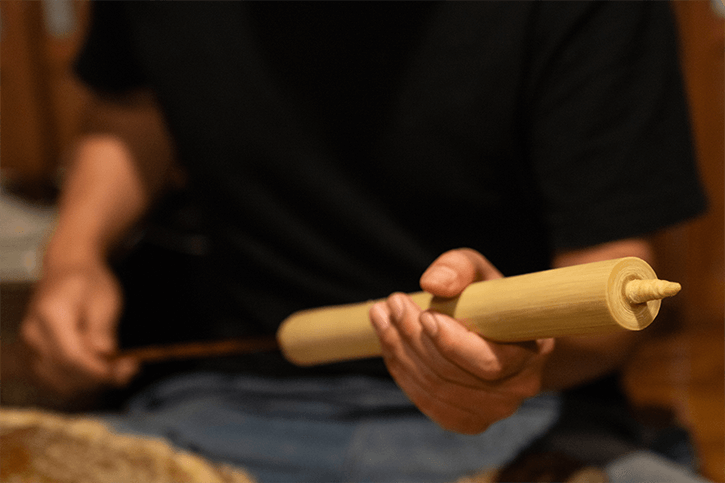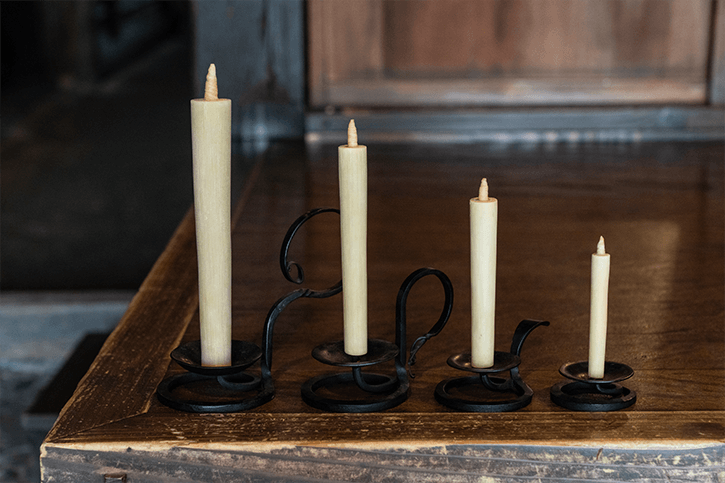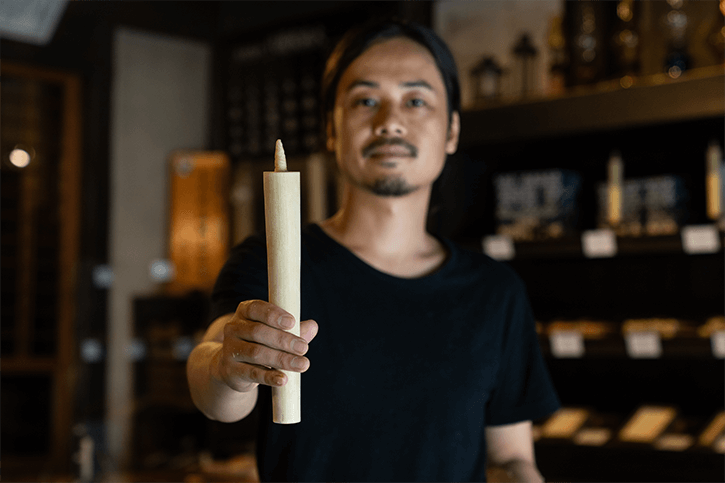
In 1878, an arc lamp was switched on in Tokyo to commemorate the opening of the Central Telegraph Office. It also marked the first use of electricity for lighting in Japan after centuries of illumination by Japanese oil lamps and candles. These are somewhat rare today, but the small town of Uchiko, Ehime Prefecture, maintains its proud heritage as a production center for traditional Japanese wax (waro or mokuro) and Japanese candles (warosoku).
-
01
Uchiko wax, from trees to tapers
![Crafting a traditional warosoku candle in Uchiko, Ehime Prefecture]()
Crafting a traditional warosoku candle in Uchiko, Ehime Prefecture
In the late 19th and early 20th centuries, Uchiko merchants controlled about 30% of wax production in Japan. They exported goods overseas and prospered on the wax trade, building lavish homes and shops that still stand in the Nakamachi district. One of these is the opulent Japanese Wax Museum & Kamihaga Residence, a home and wax-making workshop built in 1894 by the Kamihaga family.
![Raw wax and sumac berries at the Japanese Wax Museum & Kamihaga Residence]()
Raw wax and sumac berries at the Japanese Wax Museum & Kamihaga Residence
![Inside the wax extraction building at the Japanese Wax Museum & Kamihaga Residence]()
Inside the wax extraction building at the Japanese Wax Museum & Kamihaga Residence
Wax is often associated with beeswax but Uchiko produced vegetable wax from the sumac tree, part of the lacquer tree family. The various buildings on the premises surround a courtyard with sumac trees, which were planted throughout the area in the middle of the Edo period (1603–1867).
Sumac berries would be crushed into powder and steamed before the wax was extracted. It was then used for products such as Japanese candles and hair oil, or bleached in the sun and then incorporated into goods such as medicine, cosmetics and polish.![The Japanese Wax Museum & Kamihaga Residence centers on an 1894 home adorned with namako plaster]()
The Japanese Wax Museum & Kamihaga Residence centers on an 1894 home adorned with namako plaster
Renowned for its elasticity and high quality, Japanese wax was displayed at international trade shows including the Paris World Expo of 1900. You can learn about this history at the Kamihaga museum and see the traditional manufacturing methods at the nearby wax extraction building, both of which have displays in English.
-
02
Keeping the flame burning
Even though paraffin wax eclipsed the use of vegetable wax a century ago, the Uchiko wax tradition is still alive. Down the main slope in the Nakamachi district from the Japanese Wax Museum & Kamihaga Residence, past oil lamp retailer Ichi, you’ll find Omori Warosoku, a traditional Japanese candle workshop.
![Omori Warosoku is a traditional Japanese candle workshop in Uchiko]()
Omori Warosoku is a traditional Japanese candle workshop in Uchiko
The business was founded about 200 years ago in the late Edo period, and its nostalgic shop has changed little since then. Beyond the wooden lattice and noren curtain, there’s an earthen floor and a raised platform for merchandise and the cashier. Behind that is the workshop where, on most days, you can find Ryotaro Omori, the seventh-generation craftsman to make Japanese candles here. He and his father are the last candle makers of their kind in Shikoku.
![Inside the Omori Warosoku Shop]()
Inside the Omori Warosoku Shop
![Craftsman Ryotaro Omori shapes a candle with vegetable wax at 40 to 45°C]()
Craftsman Ryotaro Omori shapes a candle with vegetable wax at 40 to 45°C
Heating the vegetable wax over a charcoal brazier, Omori slowly fashions each candle by applying layer after layer over the core wick (shin) of bamboo, washi paper, rushes and floss silk. The candles are polished by hand rubbing to give them a glossy finish. Omori has just the right touch to ensure the wax retains the intended shape.
![Traditional Japanese candles at Warosoku Omori in Uchiko, Ehime]()
Traditional Japanese candles at Warosoku Omori in Uchiko, Ehime
Omori makes about 20 to 30 candles a day depending on size—they range from 7 cm to 32 cm, which burn for about 30 minutes to 14 hours, respectively. Each candle is handmade and incorporates only natural ingredients. They are odorless and a light shade of olive, which Omori describes as uguisuiro, a color named after the Japanese bush warbler.
“Candles came to Japan along with Buddhism in the Nara period (710–794) and the method of production has not changed,” says Omori, sitting near a painting of his grandfather Yataro Omori, the shop’s fifth-generation craftsman. “Compared to Western candles, Japanese candles have a bigger flame, are more resilient to gusts and produce little soot.”![Successor to an Edo period business, Omori is one of the last candle craftsmen left in Shikoku]()
Successor to an Edo period business, Omori is one of the last candle craftsmen left in Shikoku
Aside from candles, Omori Warosoku sells handmade iron candleholders, snuffers and incense. The shop’s customer base includes Buddhist temples and people who prefer traditional candles for their butsudan Buddhist household altars where deceased family members are memorialized. A growing part of its clientele, however, is made of traditional Japanese inns (ryokan), hotels, antique shops and people who want to imbue interior spaces with a relaxing, natural light.
“Japanese candles have a unique shape and texture,” says Omori. “Their soothing light can be used in meals and any other settings, and they can be enjoyed almost like a mini-campfire at home.”
To learn more about Uchiko’s history of wax manufacture and traditional candles, check out the Japanese Wax Museum & Kamihaga Residence and Omori Warosoku at the addresses below.Japanese Wax Museum & Kamihaga Residence
Uchiko 2696, Uchiko-cho, Ehime Prefecture
Phone: 0893-44-2771
Open 9:00 to 16:30
Adults 500 yen, children (6 to 15) 250 yen- Kami Haga Residence and Wax Museum
-
4.5
58 Reviews -
-
- Ehime Pref. Kitagunuchikochou Uchiko 2696
-
-
-
- 0893442771
-
-
-
- 9:00-16:30
-
View AllOmori Warosoku
Uchiko 2214, Uchiko-cho, Ehime Prefecture
Phone: 0893-43-0385
Open 9:00 to 17:00 (closed Tuesday & Saturday)
https://omoriwarosoku.jp/- Omori Japanese Candle shop
-
4.0
26 Reviews -
-
- Ehime Pref. Kitagunuchikochou Uchiko 2214
-
-
-
- 0893430385
-
-
-
- 9:00-17:00
-
View All内子の宿 織
内子3013 内子の宿 織 Uchiko











 Go here
Go here






